
Penelopides is the genus of relatively small, primarily frugivorous hornbills restricted to forested areas of the Philippines. Their common name, tarictic hornbills, is an onomatopoetic reference to the main call of several of them. They have a ridged plate-like structure on the base of their mandible. All are sexually dimorphic: males of all species are whitish-buff and black, while females of all except the Mindoro hornbill are primarily black.

Chaetocercus is a genus of hummingbirds in the family Trochilidae.

Tit-spinetails are small passerine birds of the genus Leptasthenura, belonging to the ovenbird family Furnariidae. They are found in South America, particularly the southern and Andean parts of the continent. They are somewhat similar to birds of the tit family in their shape and feeding behaviour, hence the first part of their name. The "spinetail" part of their name refers to their long, pointed tail feathers. Tit-spinetails have short rounded wings, short pointed bills and are mainly brown in colour. Their nests are built in holes or in the old nests of other birds.

The rainbow-bearded thornbill is a species of hummingbird in the "coquettes", tribe Lesbiini of subfamily Lesbiinae. It is found in Colombia, Ecuador, and Peru.

The rufous-capped thornbill is a species of hummingbird in the "coquettes", tribe Lesbiini of subfamily Lesbiinae. It is found in Bolivia, Ecuador, and Peru.

The blue-headed hummingbird is a species of hummingbird in the "emeralds", tribe Trochilini of subfamily Trochilinae. It is found only on the islands of Dominica and Martinique in the Lesser Antilles.
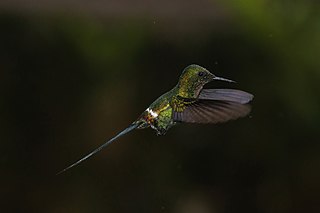
Discosura is a genus of South and Central American hummingbirds in the family Trochilidae. The thorntails are sometimes placed in the genus Popelairia, leaving Discosura for the racket-tipped thorntail. On the contrary, some have argued for merging this genus into Lophornis, which they overall resemble, except for the highly modified tail-feathers of the males.

Doricha is a genus of hummingbirds in the family Trochilidae.

The violet-headed hummingbird is a species of hummingbird in the family Trochilidae. It is the only species in the genus Klais.
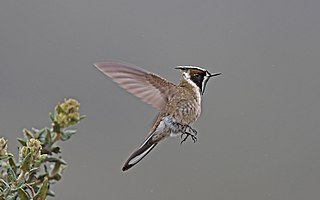
The bearded helmetcrests (Oxypogon) are a genus of hummingbird in the family Trochilidae. They are found in Colombia and Venezuela. Primary natural habitat is subtropical or tropical high-altitude grassland, known as páramo. The genus contains four species.

Canasteros and thistletails are small passerine birds of South America belonging to the genus Asthenes. The name "canastero" comes from Spanish and means "basket-maker", referring to the large, domed nests these species make of sticks or grass. They inhabit shrublands and grasslands in temperate climates from the lowlands to the highlands. They feed on insects and other invertebrates gleaned from the ground or the low vegetation.

Lepidocolaptes is a genus of birds in the ovenbird family Furnariidae. These are relatively small woodcreepers with fairly long, thin and slightly decurved bills.

Archilochus is a genus of hummingbirds. It consists of two small migratory species which breed in North America and winter in Central America, Mexico and the southern United States.

Cyanomitra is a genus of African sunbirds. Its members are sometimes included in Nectarinia.
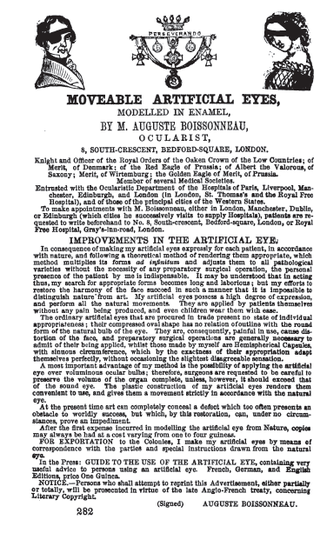
Auguste Boissonneau was a French ornithologist and ocularist. In the latter field he was a pioneer of ocular prosthesis.
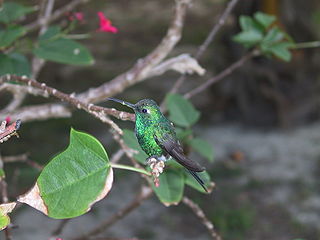
Riccordia is a genus of birds in the hummingbird family Trochilidae. They are endemic to the Caribbean.
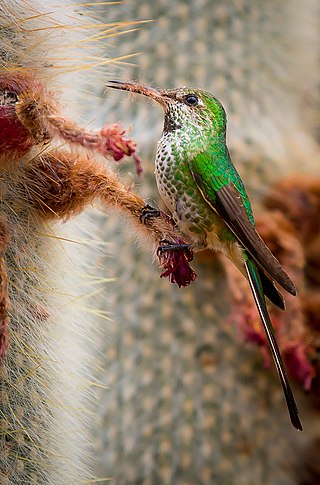
Lesbiinae is one of the six subfamilies that make up the hummingbird family Trochilidae.

Heliantheini is one of the two tribes that make up the subfamily Lesbiinae of the hummingbird family Trochilidae. The other tribe in the subfamily is Lesbiini.

Lesbiini is one of the two tribes that make up the subfamily Lesbiinae in the hummingbird family Trochilidae. The other tribe is Heliantheini (brilliants).
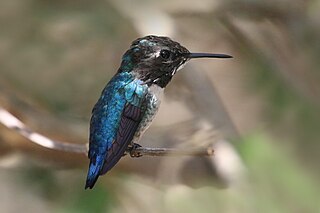
Mellisugini is one of the three tribes that make up the subfamily Trochilinae in the hummingbird family Trochilidae. The other two tribes in the subfamily are Lampornithini and Trochilini (emeralds).






























